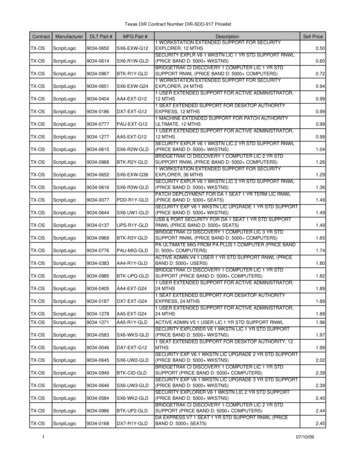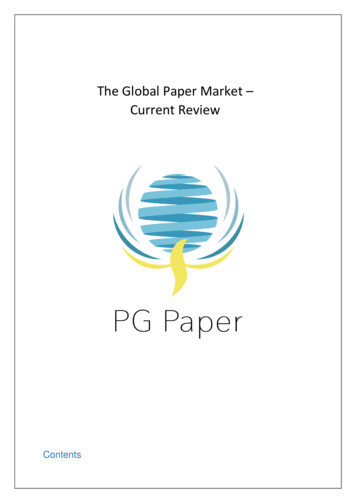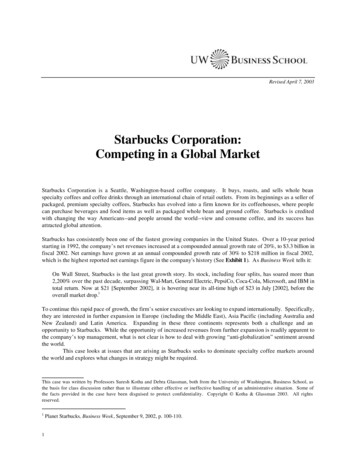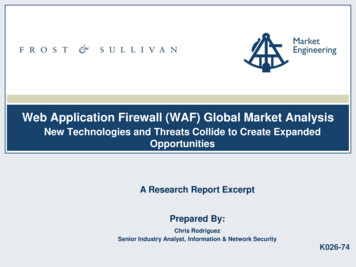
Transcription
CONTRACT MANAGEMENT SOFTWARE MARKET - GLOBAL FORECAST TO 2024MarketsandMarkets is the world's largest revenue impact company, serving over 7500customers. 80% of top 2000 companies globally rely on us for identifying new high growth andniche revenue opportunities.In the face of constant technology innovation and market disruption, we help organizations plan andoperationalize their future revenue mix decisions by identifying over 30,000 high growthopportunities ranging from 1B to 500B across 90 industry trends and markets. Organizationschoose MarketsandMarkets to stay ahead of the curve and accelerate their revenue decisionsand implementations by 6 – 12 months, giving them a unique, first-mover advantage.Our revenue impact methodology provides quantified and actionable insights on converged,granular and connected market eco-systems that result from disruptive technologies and highgrowth markets. We provide an extended lens on not only what will impact our client’s revenue butalso what will impact their clients’ revenues, continually uncovering latent opportunities.We work across all major B2B industries with C-level executives in functions such as Strategy,Marketing, Sales, R&D, Product, and M&A. MarketsandMarkets brings exclusive high-growthmarkets intelligence generated by over 850 SMEs and analysts along with its proprietary RevenueImpact platform (Knowledge Store).Copyright 2019 MarketsandMarkets All Rights Reserved. This document contains highly confidential information and is the sole propertyof MarketsandMarkets . No part of it shall be circulated, copied, quoted, or otherwise reproducedwithout the prior written approval of MarketsandMarkets .2 MarketsandMarkets
CONTRACT MANAGEMENT SOFTWARE MARKET - GLOBAL FORECAST TO 20241EXECUTIVE SUMMARYContract management is a discipline that supports commercial management through the preparation,negotiation, implementation, and oversight of legally enforceable performance commitments and riskpositions, both outbound (to the market) and inbound (from the market). It converts commercial policiesand practices, and technical capabilities into specific terms and conditions that are offered to or requiredfrom its suppliers, customers, or business partners, ensuring compliance or gaining approvals for noncompliance. Through active monitoring of performance needs and outcomes, contract managementinforms commercial management with regard to actual and required commitment capabilities, togetherwith their financial and risk impact.1Contract management started with manual overseeing, with heavy reliance on word processor, shareddrives, and spreadsheets. All contract activities were carried out offline and were tracked in spreadsheets.When new contracts needed to be drafted, the creator would find the most updated template on theshared drive and follow the approval process flow chart by walking the document to the appropriatedepartments. Problems started arising in the system when the number of contracts eventually grew, orcollaborations from multiple stakeholders were required. As companies started leveraging digitaltechnologies in the early 2000s, contract management techniques also evolved and transitioned frommanual to automated processes. Most of the large enterprises developed in-house management systems,while some of them continued using simple, and limited, databases developed by others. These systemsimproved the processes of requesting, authoring, negotiating, and approving contracts. However, businessfunctions such as legal, procurement, and sales still faced issues related to outdated drafts, making itdifficult for staff to find the most recent editions, keep track of changes, and react in a timely manner whencontracts expired. This led to liability concerns, and hence, the need for better contractmanagement software.The growth of the contract management software market can be attributed to several factors, such as therising demand for agile contract management and growing availability of the cloud-based deployments ofcontract management software. However, the primary driving factor for the contract management softwaremarket is the increasing changes in compliance regulations across regions. With recent changes inregulatory compliances, such as GDPR and HIPAA, organizations need to update their contractmanagement practices to meet the requirements. This process of change can be costly and timeconsuming, but the use of contract management software simplifies this process by providing templatesand automating the contract management process.During the forecast period, the rising demand for “Smart Contracts” and increasing automation of thecontract management process using AI and ML are expected to provide significant opportunities for thegrowth of the contract management software market. The AI/ML tools can be leveraged for refining themethods of collecting, extracting, and analyzing contract-related information and implementing newregulations, such as IFRS 16 and GDPR, which require in-depth contract review. ML can be applied tocontract provisions, such as terms, conditions, and clauses, to understand better the extent and usage oflegal language contained in existing contracts. With new updates and capabilities, ML will also be able toassist in the contract creation and compliance process. However, a few pivotal factors hindering the growthof this market are the lack of skilled expertise and privacy and security concerns.1 IACCM, Retrieved from: https://www.iaccm.com/about/contract-management/3 MarketsandMarkets
CONTRACT MANAGEMENT SOFTWARE MARKET - GLOBAL FORECAST TO 2024Many companies are still using manual methods for contract management, and upgradation to anautomated contract management software necessitates the concerned personnel to have sufficientknowledge regarding the legal framework and subject matter of the contract to define the terms andconditions of the contract successfully. As companies move their documents from legacy to digital format,the contracts’ sensitive data in these documents becomes prone to cyberattacks. Currently, many contractmanagement software providers encrypt the data to protect it from hackers; in the future, many contractmanagement services providers are expected to provide advanced protection against cybersecuritythreats.The global contract management software market has been segmented based on components (softwareand services), deployment types, organization size, business functions, verticals, and regions. Amongservices, the support and maintenance services segment is expected to have the highest market share inthe contract management software market during the forecast period. This growth is attributed to the risingadoption of contract management software, especially in North America, Europe, and APAC regions.The contract management software market by organization size includes SMEs and large enterprises. TheSMEs segment is projected to grow at a higher Compound Annual Growth Rate (CAGR), as the SMEs aregradually realizing the Return on Investment (ROI) from contract management software when comparedwith the cost of compliance. By deployment type, the contract management software market is segmentedinto on-premises and cloud. The cloud segment is expected to grow at a higher CAGR during the forecastperiod, due to the increased demand and low cost of cloud-based software. The contract managementsoftware market by business function includes legal, procurement, sales, and others such as HR, IT, andfinance. The legal segment holds the highest market share, owing to the high adoption of contractmanagement software to manage legal contracts. Among verticals, the healthcare and life sciences verticalholds the highest market share owing to the increasing deployment of contract management software toreduce operational costs and growing need to maintain compliance with regulatory mandates in thevertical.FIGURE 1CONTRACT MANAGEMENT SOFTWARE MARKET TO WITNESS SIGNIFICANTGROWTH DURING THE FORECAST PERIODMarket Size (USD 001,0001,2501,0005000201720182019-e2024-pe: estimated; p: projectedSource: Secondary Literature, Expert Interviews, and MarketsandMarkets AnalysisThe figure above depicts the global contract management software market during the forecast period. Theglobal contract management software market is expected to grow from USD 1,550 million in 2019 to USD2,917 million by 2024, at a CAGR of 13.5% during the forecast period. This growth is fueled by the demandfor efficient contract management to manage the ever-rising contract volumes across the globe.4 MarketsandMarkets
CONTRACT MANAGEMENT SOFTWARE MARKET - GLOBAL FORECAST TO 2024FIGURE 2FASTEST-GROWING SUBSEGMENTS IN THE GLOBAL CONTRACT MANAGEMENTSOFTWARE MARKET IN 201914.5%14.3%RETAIL AND ECOMMERCESMEsSalesCAGR (2019–2024)CAGR (2019–2024)CAGR (2019–2024)14.1%Note: 1 block represents 1%Source: Secondary Literature, Expert Interviews, and MarketsandMarkets Analysis5 MarketsandMarkets
CONTRACT MANAGEMENT SOFTWARE MARKET - GLOBAL FORECAST TO 2024FIGURE 3CONTRACT MANAGEMENT SOFTWARE MARKET: REGIONAL SNAPSHOTMARKET SCENARIONORTH 16.2%13.5%657380310203CAGR (2019–2024)MARKET SHARE (2019)MARKET SIZE, 2019 (USD MILLION)MARKET SHARE, BY COMPONENT 8.0%SOFTWARECOUNTRY-WISE MARKET SHARE, 4%50.8%19.2%UKChinaLatin AmericaGermanyJapanMEARest of EuropeRest of APACSource: Investor Presentation, Secondary Literature, Expert Interviews, and MarketsandMarkets AnalysisThe report also contains the profiles and the competitive leadership mapping of major technology vendors.Some major technology vendors included in the study on the contract management software market areAgiloft Inc. (Agiloft), Apptus Technologies AB (Apptus), CLM Matrix, Cobblestone Systems Corp(CobbleStone Software), AppExtremes, LLC dba Conga (Conga), Concord Worldwide, Inc. (Concord),SecureDocs, Inc. (ContractWorks), ContractsWise, Coupa Software Inc. (Coupa), Determine, Inc.(Determine), DocuSign, Inc. (DocuSign), HighQ Solutions Limited (HighQ), IBM Corporation (IBM), Icertis,Inc. (Icertis), GEP, SciQuest, Inc. d.b.a. JAGGAER (JAGGAER), SAP Ariba, Synertrade Inc. (Synertrade),Trackado, Volody (US), and Zycus Inc. (Zycus). These companies are adopting various measures, such asmergers and acquisitions, partnerships and collaborations, and new product developments, to increasetheir market shares. The report tracks and mentions the activities undertaken by these market vendors.6 MarketsandMarkets
CONTRACT MANAGEMENT SOFTWARE MARKET - GLOBAL FORECAST TO 2024Disclaimer: MarketsandMarkets provides strategic analysis services to a select group of customers inresponse to orders. Our customers acknowledge when ordering that these strategic analysis services aresolely for internal use and not for general publication or disclosure to any third party.MarketsandMarkets does not endorse any vendor, product, or service profiled in its publications.MarketsandMarkets’ strategic analysis constitutes estimations and projections based on secondary andprimary research and are therefore subject to variations.MarketsandMarkets disclaims all warranties, expressed or implied, with respect to this research, includingany warranties of merchantability or fitness, for any particular purpose.MarketsandMarkets takes no responsibility for incorrect information supplied to it by manufacturers orusers.Trademarks, copyrights, and other forms of intellectual property belong to MarketsandMarkets or theirrespective owners and are protected by law. Under no circumstance may any of these be reproduced, copied,or circulated in any form, without the prior written approval of MarketsandMarkets or its owner—as the casemay be.No part of this strategic analysis service may be given, lent, resold, or disclosed to any third party, withoutexpress permission from MarketsandMarkets .Reproduction and/or transmission in any form and by any means, including photocopying, mechanical,electronic, recording, or otherwise, without the permission of MarketsandMarkets , is prohibited.For information regarding permission, contact:Tel: 1-888-600-64417 MarketsandMarkets
manual to automated processes. Most of the large enterprises developed in-house management systems, while some of them continued using simple, and limited, databases developed by others. These systems improved the processes of requesting, authoring










